Notes: Earby is a small town (population about 6,100) in the broad valley which provides the lowest Pennine crossing between Yorkshire and Lancashire. This valley was used by the Leeds & Liverpool Canal, opened throughout in 1816. Thanks to its increased accessibility Earby developed into a small textiles centre, with cotton mills employing many of the local people. From 1848 until 1970 the valley was also followed by the Skipton-Colne railway which, unlike the canal and other trans-Pennine routes, managed to pass through the hills without any tunnels. Until April 1974 much of the route of this railway, and its branch to Barnoldswick, lay within the West Riding, but a particularly insensitive government decision redrew the boundary and handed the West Craven area to Lancashire. Thus Earby and Barnoldswick are in the Lancashire Borough of Pendle, and four decades later there is still resentment at their transfer from the White Rose to the Red Rose county.
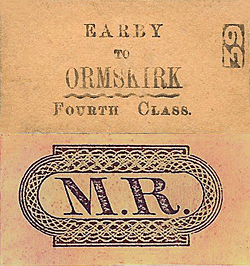 Earby station had three platform faces comprising a side platform west of the line and an island. Although intended for passenger use the outer face of the island was not served by a through line; beyond the platform the line ran the length of the goods yard and through the goods shed. The main station building was on the island platform, reached by a lattice footbridge from Colne Road. It was a somewhat plain single-storey sandstone structure with a ridged slate roof; a hipped ridge-and-furrow verandah on each platform face extended half the length of the building. Within were the booking office, waiting rooms and toilets. A similar, but shorter, stone building without a verandah stood on the up platform. The goods yard was sandwiched between the line and Colne Road. The main station entrance also served the goods yard where a weighbridge and weigh office were sited, with a secondary entrance further along Colne Road. There were initially two long sidings running parallel, one passing through the stone-built goods shed and the other passing east of it to a small end-dock. A 5-ton crane stood between the two sidings south of the goods shed. Two additional sidings were built east of, and parallel to, the existing ones. The outer face of the island was originally used by Barnoldswick branch trains, but latterly it was used only by the Saturday midday service and specials such as the Skipton Gala trains. Immediately south of the station was a level crossing on Salterforth Road. Earby Station signal box south of the crossing, on the up side, controlled the crossing and access to the goods yard. About 800yd north of the station, where the road to Skipton (now A56) crossed the railway was another box, known as Earby Crossing (but formerly Earby Gate House). When the Barnoldswick Branch opened, a further box was brought into use at Barnoldswick Junction. For a short time, a box named Earby Junction was in use a short distance south of Barnoldswick Junction; it is understood to have opened in 1916 to control access to and from the Ministry of Munitions explosives store sidings and will have been decommissioned when the store closed, prior to 1923. Earby station had three platform faces comprising a side platform west of the line and an island. Although intended for passenger use the outer face of the island was not served by a through line; beyond the platform the line ran the length of the goods yard and through the goods shed. The main station building was on the island platform, reached by a lattice footbridge from Colne Road. It was a somewhat plain single-storey sandstone structure with a ridged slate roof; a hipped ridge-and-furrow verandah on each platform face extended half the length of the building. Within were the booking office, waiting rooms and toilets. A similar, but shorter, stone building without a verandah stood on the up platform. The goods yard was sandwiched between the line and Colne Road. The main station entrance also served the goods yard where a weighbridge and weigh office were sited, with a secondary entrance further along Colne Road. There were initially two long sidings running parallel, one passing through the stone-built goods shed and the other passing east of it to a small end-dock. A 5-ton crane stood between the two sidings south of the goods shed. Two additional sidings were built east of, and parallel to, the existing ones. The outer face of the island was originally used by Barnoldswick branch trains, but latterly it was used only by the Saturday midday service and specials such as the Skipton Gala trains. Immediately south of the station was a level crossing on Salterforth Road. Earby Station signal box south of the crossing, on the up side, controlled the crossing and access to the goods yard. About 800yd north of the station, where the road to Skipton (now A56) crossed the railway was another box, known as Earby Crossing (but formerly Earby Gate House). When the Barnoldswick Branch opened, a further box was brought into use at Barnoldswick Junction. For a short time, a box named Earby Junction was in use a short distance south of Barnoldswick Junction; it is understood to have opened in 1916 to control access to and from the Ministry of Munitions explosives store sidings and will have been decommissioned when the store closed, prior to 1923.
In February 1863 Bradshaw showed five weekday and two Sunday trains each way between Skipton and Colne.
Up trains: weekdays
February 1863 |
Destination |
Down trains: weekdays |
Destination |
6.40am |
Skipton |
8.00am |
Colne |
8.40am |
Skipton |
11.48am |
Colne |
10.49am |
Skipton |
3.02pm |
Colne |
3.40pm |
Skipton |
5.23pm |
Colne |
6.25pm |
Skipton |
7.21pm |
Colne |
Up trains: Sunday |
Destination |
Down trains: Sunday |
Destination |
8.08am |
Skipton |
9.17am |
Colne |
4.10pm |
Skipton |
5.58pm |
Colne |
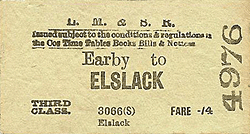 The town of Barnoldswick, just over two miles west of Earby, grew in importance when the canal reached it and stimulated the established woollen industry. It went on to specialise in cotton cloth, reflecting its links with Lancashire. After schemes for railways through the town failed, local mill owners promoted their own line and formed the Barnoldswick Railway Company. The line was authorised on 12 August 1865 and construction began two years later. The single-track route of 1 mile 1342yd left the Skipton-Colne line 55 chains south of Earby at Barnoldswick Junction and opened on 8 February 1871. The passenger shuttle was known locally as the ‘Barlick Spud’ or the ‘Spudroaster’, possibly because the diminutive engine was reminiscent of a local vendor’s portable potato roaster or because the journey time between termini was sufficient to roast a potato in the loco’s firebox; ‘Barlick’ is the normal local pronunciation of the town’s name. The town of Barnoldswick, just over two miles west of Earby, grew in importance when the canal reached it and stimulated the established woollen industry. It went on to specialise in cotton cloth, reflecting its links with Lancashire. After schemes for railways through the town failed, local mill owners promoted their own line and formed the Barnoldswick Railway Company. The line was authorised on 12 August 1865 and construction began two years later. The single-track route of 1 mile 1342yd left the Skipton-Colne line 55 chains south of Earby at Barnoldswick Junction and opened on 8 February 1871. The passenger shuttle was known locally as the ‘Barlick Spud’ or the ‘Spudroaster’, possibly because the diminutive engine was reminiscent of a local vendor’s portable potato roaster or because the journey time between termini was sufficient to roast a potato in the loco’s firebox; ‘Barlick’ is the normal local pronunciation of the town’s name.
The 1881 timetable showed all Earby-Barnoldswick trains to be ‘mixed’ – i.e. composed of passenger and goods stock. Eight trains ran each way on weekdays, with no Sunday service.
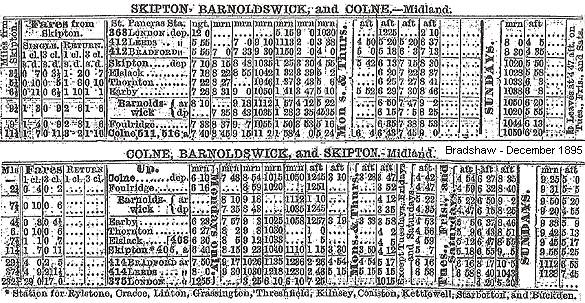
The flow of traffic from the Colne ‘branch’ was considerably weighted in favour of the Aire valley, rather than towards Lancashire, reflected in the north-facing junction of the Barnoldswick branch at Earby. In the August 1887 timetable, below, it will be seen that many of the departures for the Barnoldswick branch connected conveniently with trains from Skipton. At this time there were no Sunday trains between Earby and Barnoldswick.
Up trains: weekdays
August 1887 |
Destination |
Down trains: weekdays |
Destination |
6.23am |
Skipton |
7.26am |
Colne |
7.57am |
Skipton |
8.03am |
Barnoldswick |
9.01am |
Skipton |
8.31am |
Colne |
11.00am |
Skipton |
9.06am |
Colne |
1.07pm |
Skipton |
9.13am |
Barnoldswick |
2.32pm |
Skipton |
10.47am |
Colne |
3.43pm by request |
Skipton |
11.03am |
Barnoldswick |
4.12pm |
Skipton |
1.31pm |
Colne |
6.32pm |
Skipton |
1.38pm |
Barnoldswick |
8.41pm |
Skipton |
2.51pm |
Colne |
- |
- |
2.58pm |
Barnoldswick |
- |
- |
4.18pm |
Barnoldswick |
- |
- |
5.12pm |
Colne |
- |
- |
5.18pm |
Barnoldswick |
- |
- |
6.17pm |
Colne |
- |
- |
6.38pm |
Barnoldswick |
- |
- |
8.31pm |
Colne |
- |
- |
8.50pm |
Barnoldswick |
Up trains: Sunday |
Destination |
Down trains: Sunday |
Destination |
9.38am |
Skipton |
10.38am |
Colne |
11.43am |
Skipton |
3.03pm |
Colne |
5.03pm |
Skipton |
6.03pm |
Colne |
 In 1899 the Midland Railway obtained powers to buy the Barnoldswick Railway. In 1903 the timetable had improved to 11 weekday trains from Barnoldswick, with two extras late on Saturday, and ten weekday and two late Saturday extras from Earby. Even before World War I road transport had begun to reduce loadings on the branch, but the service was improved to attract more passengers. By 1929 there were 16 weekday departures plus one on Tuesday and Friday only. However the opening of the direct Earby-Barnoldswick Road in interwar years had a dramatic effect on loadings with 116,366 booking in 1928, collapsing to 63,608 two years later. The railway responded in 1932 by introducing a push-and-pull service as it was uneconomical to uncouple the loco from its coaches at each end of the short journey; the loco remained coupled to the coaches, pulling them to Barnoldswick and pushing them back to Earby. By 1934 weekday departures from Barnoldswick had increased to 24 with a number of through workings to Skipton, and there were even nine Sunday evening trains, though none during the day. However these heady days gave way to decline, and by 1939 Sunday trains had ceased. In 1899 the Midland Railway obtained powers to buy the Barnoldswick Railway. In 1903 the timetable had improved to 11 weekday trains from Barnoldswick, with two extras late on Saturday, and ten weekday and two late Saturday extras from Earby. Even before World War I road transport had begun to reduce loadings on the branch, but the service was improved to attract more passengers. By 1929 there were 16 weekday departures plus one on Tuesday and Friday only. However the opening of the direct Earby-Barnoldswick Road in interwar years had a dramatic effect on loadings with 116,366 booking in 1928, collapsing to 63,608 two years later. The railway responded in 1932 by introducing a push-and-pull service as it was uneconomical to uncouple the loco from its coaches at each end of the short journey; the loco remained coupled to the coaches, pulling them to Barnoldswick and pushing them back to Earby. By 1934 weekday departures from Barnoldswick had increased to 24 with a number of through workings to Skipton, and there were even nine Sunday evening trains, though none during the day. However these heady days gave way to decline, and by 1939 Sunday trains had ceased.
In World War 1 the flat valley floor south of Earby was used as a Ministry of Munitions explosives store served by lines branching from the Skipton-Colne route. Details of this facility are given in the Salterforth Bottoms Cordite Store feature.

Returning to the ‘main line’ the Midland, and from 1923 the LMS, provided a reasonable train service. The July 1938 departures from Earby are listed separately for the Skipton-Colne line and the Barnoldswick Branch for ease of reading; the frequency of departures and the variations between Monday-to-Friday and Saturday trains would otherwise have produced an even more unwieldy result. At this time the Barnoldswick service was frequent, in striking contrast to the minuscule provision in its final years.
‘Main Line’ Up trains: weekdays
July 1938 |
Destination |
Down trains: weekdays |
Destination |
6.31am |
Skipton |
7.18am |
Colne |
6.40am |
Skipton |
8.36am |
Colne |
8.04am |
Skipton |
9.09am |
Colne |
9.14am |
Skipton |
9.57am |
Colne |
10.33am MX |
Skipton |
10.22am |
Colne |
10.35am MO |
Skipton |
11.44am |
Colne |
11.20am SO |
Skipton |
12.06pm SO |
Colne |
12.40pm |
Skipton |
12.45pm SO |
Colne |
1.49pm SO |
Skipton |
1.52pm |
Colne |
2.28pm |
Skipton |
2.36pm SO |
Colne |
3.20pm SO |
Skipton |
4.07pm |
Colne |
4.07pm |
Skipton |
5.24pm SX |
Colne |
5.04pm SX |
Skipton |
5.29pm SO |
Colne |
5.15pm SX |
Skipton |
5.51pm |
Colne |
6.06pm SO |
Skipton |
6.00pm SO |
Colne |
6.52pm |
Skipton |
6.08pm SX |
Colne |
7.35pm SX |
Skipton |
7.05pm |
Colne |
8.10pm SO |
Skipton |
8.29pm |
Colne |
9.30pm SX |
Skipton |
8.50pm SX |
Colne |
9.49pm |
Skipton |
9.34pm SO |
Colne |
10.31pm |
Skipton |
9.37pm SX |
Colne |
11.17pm SO |
Skipton |
10.42pm SO |
Colne |
12.21am SO |
Skipton |
12.05am SO |
Colne |
‘Main Line’ Up trains: Sunday |
Destination |
Down trains: Sunday |
Destination |
7.55am |
Skipton |
9.51am |
Colne |
9.02am |
Skipton |
11.13am |
Colne |
11.47am |
Skipton |
6.49pm |
Colne |
4.56pm |
Skipton |
8.19pm |
Colne |
7.50pm |
Skipton |
9.11pm |
Colne |
9.14pm |
Skipton |
- |
- |
9.33pm |
Skipton |
- |
- |
Departures for Barnoldswick July 1938
Weekdays |
Weekdays |
Weekdays |
Weekdays |
Weekdays |
Sunday |
6.43am |
11.47am |
4.13pm |
6.56pm |
10.50pm SO |
4.31pm |
7.23am |
12.11pm |
4.38pm SX |
7.15pm |
11.47pm SO |
5.00pm |
8.06am |
12.50pm |
5.10pm SX |
7.40pm |
12.25pm SO |
5.45pm |
8.40am |
1.22pm |
5.32pm SO |
8.00pm SO |
- |
6.15pm |
9.17am |
1.54pm SX |
5.39pm SX |
8.33pm |
- |
6.53pm |
10.02am |
2.02pm SO |
5.58pm SK |
8.55pm SX |
- |
7.53pm |
10.45am |
3.25pm SK |
6.08pm SO |
9.51pm |
- |
8.25pm |
11.22am SO |
3.33pm SO |
6.30pm |
10.40pm SX |
- |
9.15pm |
- |
- |
- |
- |
- |
10.19pm |
MO Monday only; MX Monday excepted; SO Saturday only; SX Saturday excepted.
In January 1948 the Skipton-Colne line and the Barnoldswick Branch were allocated to the London Midland Region. By summer 1956 the services to Colne and Skipton were less frequent than in LMS days. The Barnoldswick Branch train service was reduced from 24 to about 12 trains on Monday-to-Friday in the early 1950s – with a more generous service on Saturday, but none on Sunday - a response to increased use of cars and buses. On Saturdays only there were five trains each way after 7.15pm to provide for the recreational needs of the ‘Barlickers’.
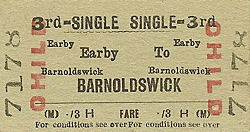 In September 1956 the train services on the Barnoldswick Branch were drastically reduced: the following summer timetable showed from Barnoldswick only 8.19am and 5.00pm (Saturdays excepted) departures for Earby and Skipton, and in the opposite direction the 11.45am (Saturdays only) from Earby to Skipton, and a Saturdays excepted through train from Skipton, departing from Earby at 4.42pm to Barnoldswick. The train service was maintained for boys attending Ermysted’s Grammar School and girls at the High School, both in Skipton, and for students attending college in Keighley. The morning departure from Barnoldswick also operated on Saturday as classes were held at the Grammar School. From 1959 the afternoon service was provided by a diesel multiple unit. Barbara Dutton was one of the high school girls who made the daily journey from Earby to Skipton in the late 1950s and early ‘60s. She recalls that girls and boys were strictly segregated in the train, to avoid the risk of ‘hanky-panky’, and they were also kept apart by teachers as they processed from Skipton station to their respective schools. There was an understanding that if the morning train from Barnoldswick failed to reach Earby by 8.30 then pupils could go home, and how – to their disappointment - the train invariably turned up on time. However on one very cold morning the points froze at Barnoldswick Junction, preventing the train from leaving the branch. The signalman at Earby came to its rescue, using a kettle of boiled water to thaw the points, and the train chuffed into Earby just before 8.30, to the children’s jeers of contempt. In September 1956 the train services on the Barnoldswick Branch were drastically reduced: the following summer timetable showed from Barnoldswick only 8.19am and 5.00pm (Saturdays excepted) departures for Earby and Skipton, and in the opposite direction the 11.45am (Saturdays only) from Earby to Skipton, and a Saturdays excepted through train from Skipton, departing from Earby at 4.42pm to Barnoldswick. The train service was maintained for boys attending Ermysted’s Grammar School and girls at the High School, both in Skipton, and for students attending college in Keighley. The morning departure from Barnoldswick also operated on Saturday as classes were held at the Grammar School. From 1959 the afternoon service was provided by a diesel multiple unit. Barbara Dutton was one of the high school girls who made the daily journey from Earby to Skipton in the late 1950s and early ‘60s. She recalls that girls and boys were strictly segregated in the train, to avoid the risk of ‘hanky-panky’, and they were also kept apart by teachers as they processed from Skipton station to their respective schools. There was an understanding that if the morning train from Barnoldswick failed to reach Earby by 8.30 then pupils could go home, and how – to their disappointment - the train invariably turned up on time. However on one very cold morning the points froze at Barnoldswick Junction, preventing the train from leaving the branch. The signalman at Earby came to its rescue, using a kettle of boiled water to thaw the points, and the train chuffed into Earby just before 8.30, to the children’s jeers of contempt.

Trains ceased to call at Earby on Sunday circa 1957.
It was no surprise to find the Earby – Barnoldswick line recommended for closure in the ‘Beeching’ report of March 1963; no mention was made of the Skipton-Colne service although Thornton-in-Craven was to close. On 4 September 1964, even though closure had not yet been sanctioned, school season tickets from Barnoldswick were withdrawn and the local authorities were obliged to provide six motor coaches for the young people who attended school in Skipton and Keighley. A solitary dirty carriage was provided for the now almost-empty morning train. On 19 July 1965 the Minister of Transport consented to closure of the Barnoldswick Branch to passengers which took place on 27 September 1965. The last coal train used the branch on 30 July 1966. Earby goods yard had closed on 1 March 1965.
Up trains: weekdays
June 1964 |
Destination |
Down trains: weekdays |
Destination |
6.35am |
Skipton |
7.10am |
Manchester Vic |
8.00am |
Skipton |
8.39am |
Liverpool Exch |
8.27am |
Skipton |
9.25am |
Accrington |
9.05am |
Skipton |
10.03am |
Manchester Vic |
10.01am |
Skipton |
11.25am |
Preston |
10.55am |
Skipton |
11.52am SO |
Barnoldswick |
12.40pm |
Skipton |
12.04pm |
Manchester Vic |
1.50pm |
Skipton |
2.05pm |
Manchester Vic |
2.39pm SO |
Skipton |
3.03pm |
Colne |
2.43pm SK |
Skipton |
4.15pm |
Colne |
4.40pm |
Skipton |
4.41pm SX |
Barnoldswick |
5.07pm |
Skipton |
5.18pm |
Colne |
5.35pm |
Skipton |
6.05pm |
Manchester Vic |
6.12pm SO |
Skipton |
7.06pm |
Manchester Vic |
6.29pm SX |
Skipton |
8.06pm |
Manchester Vic |
6.44pm SX |
Skipton |
10.33pm |
Accrington |
6.58pm |
Skipton |
- |
- |
8.40pm |
Skipton |
- |
- |
9.39pm |
Skipton |
- |
- |
SO Saturday only SX Saturday excepted
In later years Earby signal box displayed a BR(LM) wooden totem sign, but no clear evidence has been found of totems installed on the platforms. LMS ‘Hawkseye’ signs were in place until the late 1950s when BR(LM) vitreous enamel running-in nameboards replaced them. Gas lamps were used and would never to give way to electric lighting.
The May 1969 timetable showed eight departures in each direction from Earby, calling on weekdays only. The frequency of departures is conspicuously less than in 1964.
Up trains: weekdays
May 1969 |
Destination |
Down trains: weekdays |
Destination |
06.32 |
Skipton |
06.58 |
Manchester Vic |
08.34 |
Skipton |
09.00 |
Manchester Vic |
09.18 |
Skipton |
10.00 |
Blackpool North |
11.10 |
Skipton |
11.57 |
Blackpool North |
13.17 |
Skipton |
13.57 |
Blackpool North |
15.10 |
Skipton |
16.00 |
Blackpool North |
17.34 |
Skipton |
18.03 |
Blackpool North |
20.10 |
Skipton |
21.08 |
Manchester Vic |
As described in the Brief History page, the annual BR timetable issued in May 1969 was to be the last for Earby and Thornton-in-Craven stations as the Skipton-Colne line closed to all traffic on 2 February 1970.
 At Earby station photographic evidence indicates that the rails, footbridge and signal box were still in place in 1971 but the date of their removal has not been established. John Mann’s photographs of January 1974 show that the rails have been lifted, and vegetation on the trackbed suggests that this had taken place some time before. The signal box at Earby Crossing was rescued for re-use at Damems station on the Keighley & Worth Valley Railway. Earby’s platforms and vandalised buildings survived until demolition in winter 1976-77. By May 1977 the trackbed through the site of the station had been transformed into a footpath and on the site of the platforms saplings had been planted; today these have matured into tall trees casting the path into deep shade in summer. Nothing remains of the passenger buildings but the goods yard is now a small industrial estate in which the weighbridge office and goods shed survive. At Earby station photographic evidence indicates that the rails, footbridge and signal box were still in place in 1971 but the date of their removal has not been established. John Mann’s photographs of January 1974 show that the rails have been lifted, and vegetation on the trackbed suggests that this had taken place some time before. The signal box at Earby Crossing was rescued for re-use at Damems station on the Keighley & Worth Valley Railway. Earby’s platforms and vandalised buildings survived until demolition in winter 1976-77. By May 1977 the trackbed through the site of the station had been transformed into a footpath and on the site of the platforms saplings had been planted; today these have matured into tall trees casting the path into deep shade in summer. Nothing remains of the passenger buildings but the goods yard is now a small industrial estate in which the weighbridge office and goods shed survive.
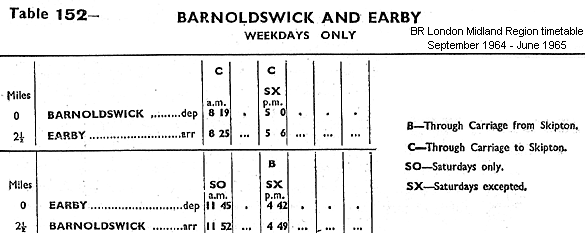
Tickets from Michael Stewart, Bradshaws from Chris Totty, Totem from Richard Furness, route map drawn by Alan Young.
Click here for details of a commemorative set of 6 colour postcards of the Barnoldswick - Earby Railway produced for the 30th anniversary of closure in 1995 - £1.75 per set
Click here to see of a 6 minute film with includes a journey from Earby to Barnoldswick.
Click here to see some surviving railway features around Earby and Barnoldswick Junction
Sources:
Click here for a brief history of the Colne - Skipton line
See also: Foulridge, Thornton-in-Craven & Elslack
plus Barnoldswick
See also: Salterforth Bottoms Cordite Store |

old2.jpg)

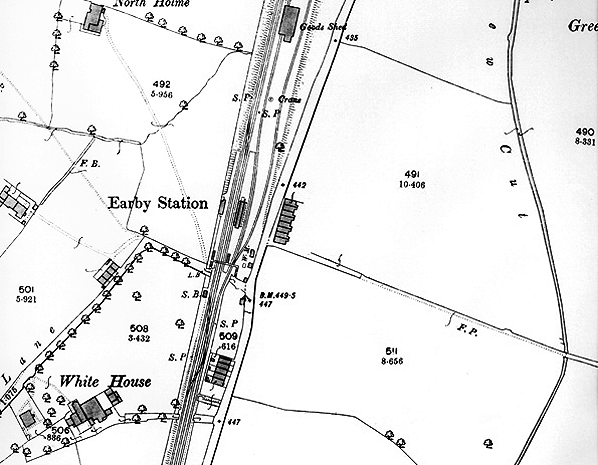
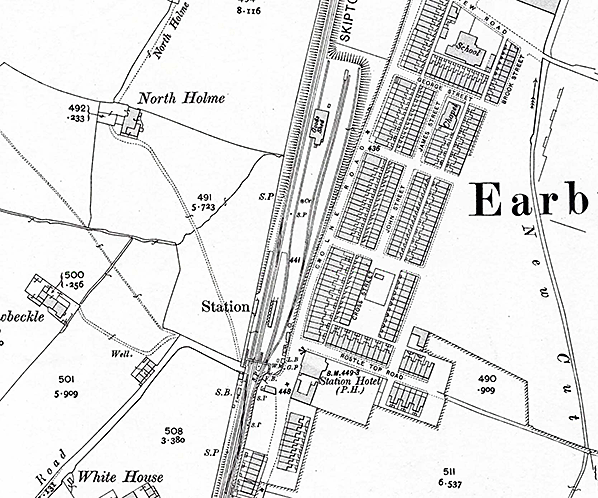
old3.jpg)
old4.jpg)
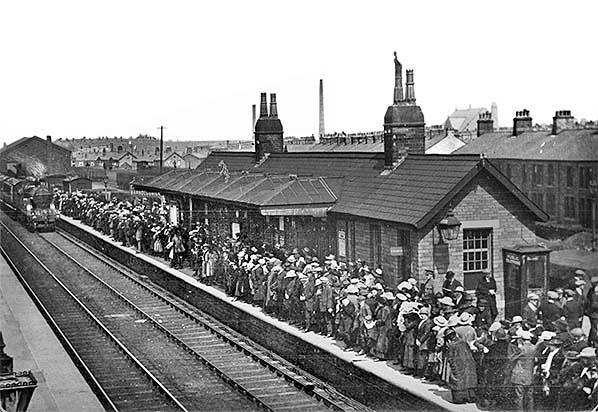
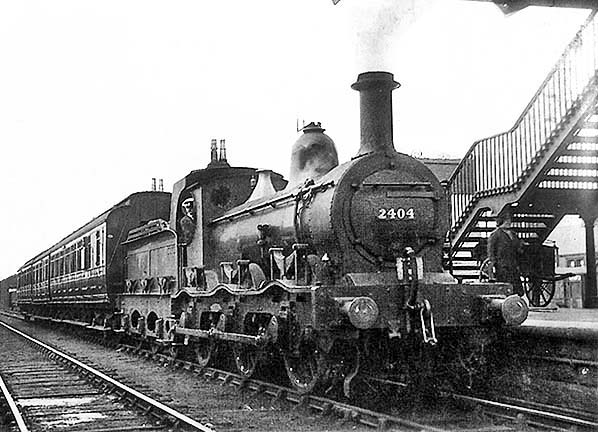

old8.jpg) A southbound goods train passes through Earby station in August 1949.
A southbound goods train passes through Earby station in August 1949.
 Earby station had three platform faces comprising a side platform west of the line and an island. Although intended for passenger use the outer face of the island was not served by a through line; beyond the platform the line ran the length of the goods yard and through the goods shed. The main station building was on the island platform, reached by a lattice footbridge from Colne Road. It was a somewhat plain single-storey sandstone structure with a ridged slate roof; a hipped ridge-and-furrow verandah on each platform face extended half the length of the building. Within were the booking office, waiting rooms and toilets. A similar, but shorter, stone building without a verandah stood on the up platform. The goods yard was sandwiched between the line and Colne Road. The main station entrance also served the goods yard where a weighbridge and weigh office were sited, with a secondary entrance further along Colne Road. There were initially two long sidings running parallel, one passing through the stone-built goods shed and the other passing east of it to a small end-dock. A 5-ton crane stood between the two sidings south of the goods shed. Two additional sidings were built east of, and parallel to, the existing ones. The outer face of the island was originally used by Barnoldswick branch trains, but latterly it was used only by the Saturday midday service and specials such as the Skipton Gala trains. Immediately south of the station was a level crossing on Salterforth Road. Earby Station signal box south of the crossing, on the up side, controlled the crossing and access to the goods yard. About 800yd north of the station, where the road to Skipton (now A56) crossed the railway was another box, known as Earby Crossing (but formerly Earby Gate House). When the Barnoldswick Branch opened, a further box was brought into use at Barnoldswick Junction. For a short time, a box named Earby Junction was in use a short distance south of Barnoldswick Junction; it is understood to have opened in 1916 to control access to and from the Ministry of Munitions explosives store sidings and will have been decommissioned when the store closed, prior to 1923.
Earby station had three platform faces comprising a side platform west of the line and an island. Although intended for passenger use the outer face of the island was not served by a through line; beyond the platform the line ran the length of the goods yard and through the goods shed. The main station building was on the island platform, reached by a lattice footbridge from Colne Road. It was a somewhat plain single-storey sandstone structure with a ridged slate roof; a hipped ridge-and-furrow verandah on each platform face extended half the length of the building. Within were the booking office, waiting rooms and toilets. A similar, but shorter, stone building without a verandah stood on the up platform. The goods yard was sandwiched between the line and Colne Road. The main station entrance also served the goods yard where a weighbridge and weigh office were sited, with a secondary entrance further along Colne Road. There were initially two long sidings running parallel, one passing through the stone-built goods shed and the other passing east of it to a small end-dock. A 5-ton crane stood between the two sidings south of the goods shed. Two additional sidings were built east of, and parallel to, the existing ones. The outer face of the island was originally used by Barnoldswick branch trains, but latterly it was used only by the Saturday midday service and specials such as the Skipton Gala trains. Immediately south of the station was a level crossing on Salterforth Road. Earby Station signal box south of the crossing, on the up side, controlled the crossing and access to the goods yard. About 800yd north of the station, where the road to Skipton (now A56) crossed the railway was another box, known as Earby Crossing (but formerly Earby Gate House). When the Barnoldswick Branch opened, a further box was brought into use at Barnoldswick Junction. For a short time, a box named Earby Junction was in use a short distance south of Barnoldswick Junction; it is understood to have opened in 1916 to control access to and from the Ministry of Munitions explosives store sidings and will have been decommissioned when the store closed, prior to 1923. The town of Barnoldswick, just over two miles west of Earby, grew in importance when the canal reached it and stimulated the established woollen industry. It went on to specialise in cotton cloth, reflecting its links with Lancashire. After schemes for railways through the town failed, local mill owners promoted their own line and formed the Barnoldswick Railway Company. The line was authorised on 12 August 1865 and construction began two years later. The single-track route of 1 mile 1342yd left the Skipton-Colne line 55 chains south of Earby at Barnoldswick Junction and opened on 8 February 1871. The passenger shuttle was known locally as the ‘Barlick Spud’ or the ‘Spudroaster’, possibly because the diminutive engine was reminiscent of a local vendor’s portable potato roaster or because the journey time between termini was sufficient to roast a potato in the loco’s firebox; ‘Barlick’ is the normal local pronunciation of the town’s name.
The town of Barnoldswick, just over two miles west of Earby, grew in importance when the canal reached it and stimulated the established woollen industry. It went on to specialise in cotton cloth, reflecting its links with Lancashire. After schemes for railways through the town failed, local mill owners promoted their own line and formed the Barnoldswick Railway Company. The line was authorised on 12 August 1865 and construction began two years later. The single-track route of 1 mile 1342yd left the Skipton-Colne line 55 chains south of Earby at Barnoldswick Junction and opened on 8 February 1871. The passenger shuttle was known locally as the ‘Barlick Spud’ or the ‘Spudroaster’, possibly because the diminutive engine was reminiscent of a local vendor’s portable potato roaster or because the journey time between termini was sufficient to roast a potato in the loco’s firebox; ‘Barlick’ is the normal local pronunciation of the town’s name.
 In 1899 the Midland Railway obtained powers to buy the Barnoldswick Railway. In 1903 the timetable had improved to 11 weekday trains from Barnoldswick, with two extras late on Saturday, and ten weekday and two late Saturday extras from Earby. Even before World War I road transport had begun to reduce loadings on the branch, but the service was improved to attract more passengers. By 1929 there were 16 weekday departures plus one on Tuesday and Friday only. However the opening of the direct Earby-Barnoldswick Road in interwar years had a dramatic effect on loadings with 116,366 booking in 1928, collapsing to 63,608 two years later. The railway responded in 1932 by introducing a push-and-pull service as it was uneconomical to uncouple the loco from its coaches at each end of the short journey; the loco remained coupled to the coaches, pulling them to Barnoldswick and pushing them back to Earby. By 1934 weekday departures from Barnoldswick had increased to 24 with a number of through workings to Skipton, and there were even nine Sunday evening trains, though none during the day. However these heady days gave way to decline, and by 1939 Sunday trains had ceased.
In 1899 the Midland Railway obtained powers to buy the Barnoldswick Railway. In 1903 the timetable had improved to 11 weekday trains from Barnoldswick, with two extras late on Saturday, and ten weekday and two late Saturday extras from Earby. Even before World War I road transport had begun to reduce loadings on the branch, but the service was improved to attract more passengers. By 1929 there were 16 weekday departures plus one on Tuesday and Friday only. However the opening of the direct Earby-Barnoldswick Road in interwar years had a dramatic effect on loadings with 116,366 booking in 1928, collapsing to 63,608 two years later. The railway responded in 1932 by introducing a push-and-pull service as it was uneconomical to uncouple the loco from its coaches at each end of the short journey; the loco remained coupled to the coaches, pulling them to Barnoldswick and pushing them back to Earby. By 1934 weekday departures from Barnoldswick had increased to 24 with a number of through workings to Skipton, and there were even nine Sunday evening trains, though none during the day. However these heady days gave way to decline, and by 1939 Sunday trains had ceased. 
 In September 1956 the train services on the Barnoldswick Branch were drastically reduced: the following summer timetable showed from Barnoldswick only 8.19am and 5.00pm (Saturdays excepted) departures for Earby and Skipton, and in the opposite direction the 11.45am (Saturdays only) from Earby to Skipton, and a Saturdays excepted through train from Skipton, departing from Earby at 4.42pm to Barnoldswick. The train service was maintained for boys attending Ermysted’s Grammar School and girls at the High School, both in Skipton, and for students attending college in Keighley. The morning departure from Barnoldswick also operated on Saturday as classes were held at the Grammar School. From 1959 the afternoon service was provided by a diesel multiple unit. Barbara Dutton was one of the high school girls who made the daily journey from Earby to Skipton in the late 1950s and early ‘60s. She recalls that girls and boys were strictly segregated in the train, to avoid the risk of ‘hanky-panky’, and they were also kept apart by teachers as they processed from Skipton station to their respective schools. There was an understanding that if the morning train from Barnoldswick failed to reach Earby by 8.30 then pupils could go home, and how – to their disappointment - the train invariably turned up on time. However on one very cold morning the points froze at Barnoldswick Junction, preventing the train from leaving the branch. The signalman at Earby came to its rescue, using a kettle of boiled water to thaw the points, and the train chuffed into Earby just before 8.30, to the children’s jeers of contempt.
In September 1956 the train services on the Barnoldswick Branch were drastically reduced: the following summer timetable showed from Barnoldswick only 8.19am and 5.00pm (Saturdays excepted) departures for Earby and Skipton, and in the opposite direction the 11.45am (Saturdays only) from Earby to Skipton, and a Saturdays excepted through train from Skipton, departing from Earby at 4.42pm to Barnoldswick. The train service was maintained for boys attending Ermysted’s Grammar School and girls at the High School, both in Skipton, and for students attending college in Keighley. The morning departure from Barnoldswick also operated on Saturday as classes were held at the Grammar School. From 1959 the afternoon service was provided by a diesel multiple unit. Barbara Dutton was one of the high school girls who made the daily journey from Earby to Skipton in the late 1950s and early ‘60s. She recalls that girls and boys were strictly segregated in the train, to avoid the risk of ‘hanky-panky’, and they were also kept apart by teachers as they processed from Skipton station to their respective schools. There was an understanding that if the morning train from Barnoldswick failed to reach Earby by 8.30 then pupils could go home, and how – to their disappointment - the train invariably turned up on time. However on one very cold morning the points froze at Barnoldswick Junction, preventing the train from leaving the branch. The signalman at Earby came to its rescue, using a kettle of boiled water to thaw the points, and the train chuffed into Earby just before 8.30, to the children’s jeers of contempt. 
 At Earby station photographic evidence indicates that the rails, footbridge and signal box were still in place in 1971 but the date of their removal has not been established. John Mann’s photographs of January 1974 show that the rails have been lifted, and vegetation on the trackbed suggests that this had taken place some time before. The signal box at Earby Crossing was rescued for re-use at Damems station on the Keighley & Worth Valley Railway. Earby’s platforms and vandalised buildings survived until demolition in winter 1976-77. By May 1977 the trackbed through the site of the station had been transformed into a footpath and on the site of the platforms saplings had been planted; today these have matured into tall trees casting the path into deep shade in summer. Nothing remains of the passenger buildings but the goods yard is now a small industrial estate in which the weighbridge office and goods shed survive.
At Earby station photographic evidence indicates that the rails, footbridge and signal box were still in place in 1971 but the date of their removal has not been established. John Mann’s photographs of January 1974 show that the rails have been lifted, and vegetation on the trackbed suggests that this had taken place some time before. The signal box at Earby Crossing was rescued for re-use at Damems station on the Keighley & Worth Valley Railway. Earby’s platforms and vandalised buildings survived until demolition in winter 1976-77. By May 1977 the trackbed through the site of the station had been transformed into a footpath and on the site of the platforms saplings had been planted; today these have matured into tall trees casting the path into deep shade in summer. Nothing remains of the passenger buildings but the goods yard is now a small industrial estate in which the weighbridge office and goods shed survive. 


 Home Page
Home Page